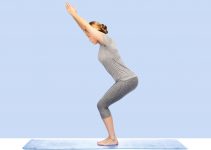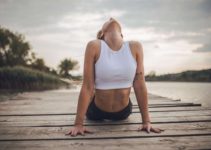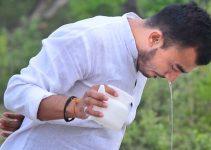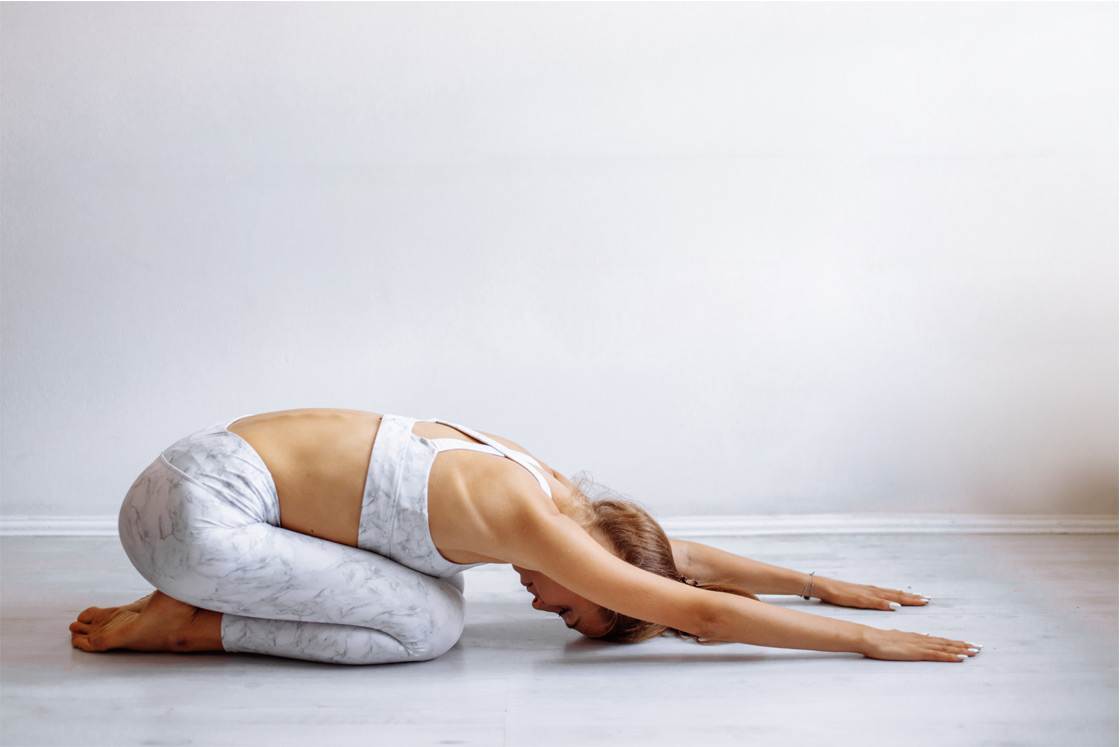
Image Source: Shutterstock
Think of a child! Their innocence, happiness, clarity, and the way they relax is what comes to mind. Do you want to bring these qualities to you?
You can surprisingly bring these qualities in yourself with the help of yoga asana practice. Balasana or also known as Child Pose is one such pose that can help you to relax like a baby.
Balasana: The Child Pose
Balasana is a forward bending sitting posture, that makes the body cheerful and calm. This pose is an excellent resting pose, to give body sensations of deep relaxation and peace.
In a yoga session, this pose is mostly used at the end of a vigorous pose to freely stretch the ankles, thighs, hips back, shoulder, and neck. It gives progressive relief to back pain.
In Child Pose, the body structure resembles a baby. Here, the practitioner looks very similar to a fetus, that’s why we call it the Child Pose or Balasana.
How to Perform Child Pose(Balasana)
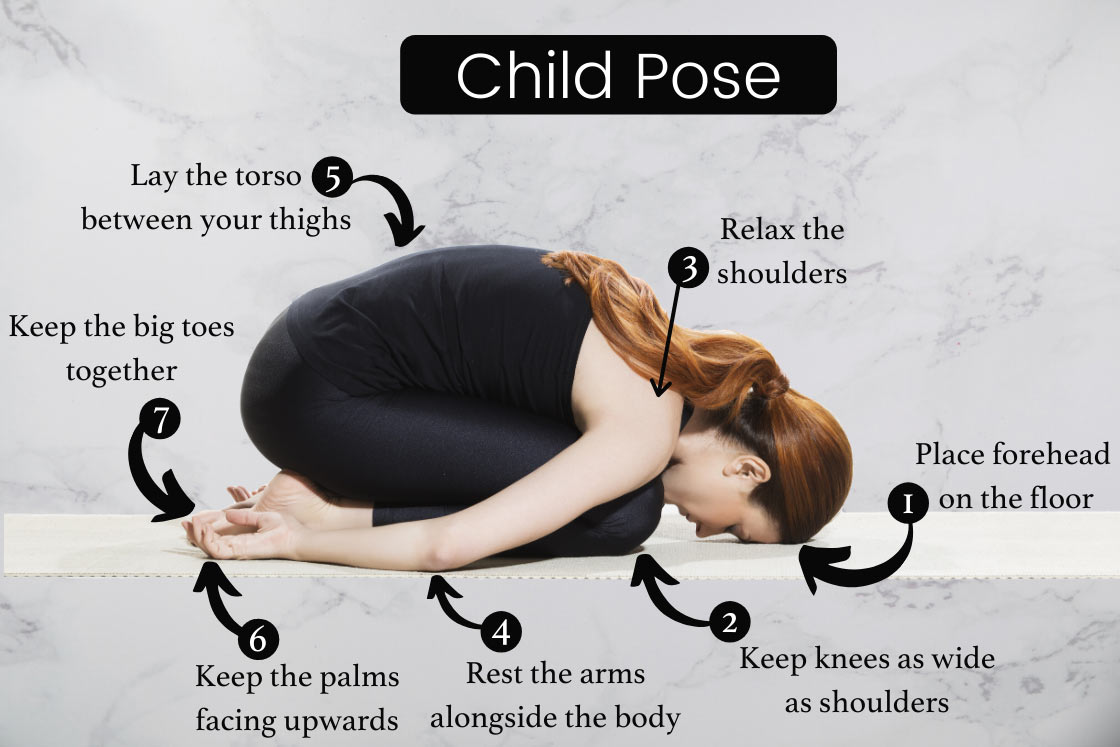
You can always remember the key points of performing Balasana using the illustration above.
Child Pose Step by Step Instructions
- Come on your knees and join the big toes together.
- Now, sit on the heels of your feet and make yourself comfortable. Then spread the knees shoulder-width apart (about 6-12 inches).
Note- Here, your crus should be flat on the floor, the soles of feet should be against the floor. The heels might get apart but keep the big toes together. Heels should be peeking out from the sides of the thighs.
- With an exhalation, bend forward, stretch your back and place your forehead on the floor. Make sure your torso is laid between your thighs.
- Now, bring the arms alongside your body and relax them, palms facing upwards. Here your palms will be next to your feet.
- Then, close your eyes and take some deep breaths for the flow of Prana. Bring your awareness to your Chitta and relax.
Note: Hold this position as much as you are comfortable, between 30 seconds to 3 minutes.
- When you are done, take a long and deep breath. With an exhalation, gently stretch the back and lift your torso.
- Then, unfold your legs and straighten them. Now, lay down on the floor and relax.
Advance Form of Child Pose
You can also perform an advanced form of Child Pose.
In this pose, the shoulders and arm muscles are also stretch along with other muscles in Child Pose. It increases the strength and flexibility of the arms and shoulders as well. This advanced form is called Extended Child Pose.
In Extended Child Pose, the body remains the same as Child Pose, except the arms and shoulders.
Here you have to place your arms straight on the floor. The palms are in the line of knees and facing downwards. Try to stretch the muscles of the arm and feel some pressure on your shoulder.
Beginner Tips
For a beginner, it is often difficult to place your feet flat on the floor for a long period, in this asana. So, it’s okay if you can’t place your feet flat on the floor. Just keep them stretched as much as you can.
- Props can aid in your practice
If you are feeling hard to touch your forehead on the floor, you can place a yoga block on the floor and place your head on it. You can also place a pillow under your forehead for better comfort to your forehead.
You can place a folded blanket between your heels and hips for better support. Also, you can use a folded blanket under your knees, to reduce pressure on your knees.
Note- Practicing a Child Pose on a yoga mat is highly advised, whether you are a beginner or an advanced practitioner. It will help you a lot in every yoga practice, and in this practice as well.
Precautions and Contraindications of Child Pose
- Put on comfortable clothing before coming to this asana.
- As this asana creates a good amount of pressure in your stomach, so a Diarrhea patient can get the ill effects from this asana. Therefore, if you are suffering from Diarrhea, you should avoid Balasana. You can continue it after getting cured.
- As this asana promotes better flow fo the blood in the body, so high blood pressure patients can create health hazards in this asana. Therefore, a high blood pressure patient should avoid this asana.
- If you are having a recent or deep injury in your feet, knees, thighs, spine or neck, do not perform it at all.
- Perform this asana only with an empty stomach.
Benefits of Child Pose (Balasana)
Child Pose is a resting and soothing pose that helps in the deep relaxation of the body and mind. Also, it increases the overall flexibility of the body. It comes with a lot of physical and mental benefits that are listed below.
Physical Benefits
- Child Pose gently stretches the neck, back, hips, thighs, knees, and ankles. Through this stretch, this asana helps these muscles in the following aspects.
- Tones and strengthens these muscles.
- It relieves the muscle tension and stress of these muscles.
- Elevates the muscle function of these areas.
- This asana lengthens the spine & make it more flexible. This flexibility further is helpful in relieving muscle pain on the spine.
- The practice of the Child Pose promotes the circulation of blood throughout the body, especially in the head region. The flow of blood to the brain calms the mind and reduces anxiety and stress.
Also, this asana soothes the central nervous system that helps in relaxing the mind and body.
Spiritual Benefits
- On combining box breathing while being in Balasana, it improves the flow of Prana to the whole body. Thus, this asana promotes the overall functioning of the body at the spiritual level.
- Child Pose brings a sense of joy and happiness. It fills you with positive feelings and gives you a sensation of a child’s mental peace and innocence. It brings mental clarity and emotional solace to the practitioner.
Child Pose FAQs
For whom Balasana is most beneficial?
People who spend most of their time in sitting position, such as, students, desk job workers, etc, must practice this asana. Sitting for a prolonged period reduces mobility and strength of the spine and regular practice of this asana, gradually increases mobility and strength of the spine.
Can Balasana or Child Pose reduce Sciatica?
Yes. Since Balasana or Child Pose stretches the muscles of the lower body (hips, thighs, calves, knees, ankles, and feet), this asana can gradually reduce Sciatica and the pain caused by it.
Can I perform Child Pose after gym or workout?
Yes, of course. You can do Child Pose after a workout. This asana will relax all the overstretched muscles of the body after the workout.
